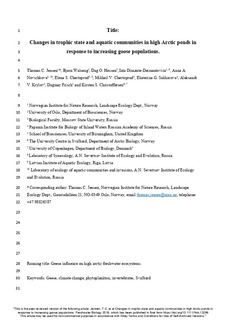| dc.description.abstract | 1. The high Arctic, including the Svalbard archipelago in the North Atlantic, has been exposed to direct and indirect drivers of climatic change such as rising temperatures and associated changes in hydrology and nutrient fluxes. In addition, the number of migrating birds, particularly geese, increased remarkably in the Svalbard archipelago during the second half of the last century. The higher number of breeding birds potentially affects water quality and the biota in ponds and lakes. 2. We aimed to investigate the potential influence of increasing goose abundance on trophic state, taxon richness, and species composition of freshwater communities in the high Arctic. We hypothesised that higher goose abundance affects the trophic state of shallow lakes and ponds and their taxon richness and species composition. We conducted a survey of selected ponds at Svalbard along a goose abundance gradient. We used the number of area-specific goose droppings (range of 0–94 droppings m2) as a proxy of goose presence and measured proxies for productivity as well as taxon richness and composition of phytoplankton and invertebrate communities. 3. Presence and abundance of geese were associated with higher productivity of ponds. Invertebrate and phytoplankton taxon richness correlated (positively) with goose abundance. Both phytoplankton and invertebrate taxon richness increased with increasing nitrogen (N) concentrations. Goose abundance significantly affected phytoplankton species composition, while concentrations of total-N and total phosphorus (P) did not. Species composition of aquatic invertebrates was most strongly affected by goose abundance, but the effect of total-N concentration was also significant. 4. Increased goose abundance was associated with bird driven nutrient enrichment, increased phytoplankton and invertebrate taxon richness and changes of these biological communities. Thus, in addition to climate change, the higher abundances of large migratory water fowl in many polar areas may pose a major additional stress to arctic lakes and ponds. In fact, climate change and bird impact may interact, accelerating ongoing environmental change of arctic freshwater ecosystems. climate change, geese, invertebrates, phytoplankton, Svalbard | nb_NO |
